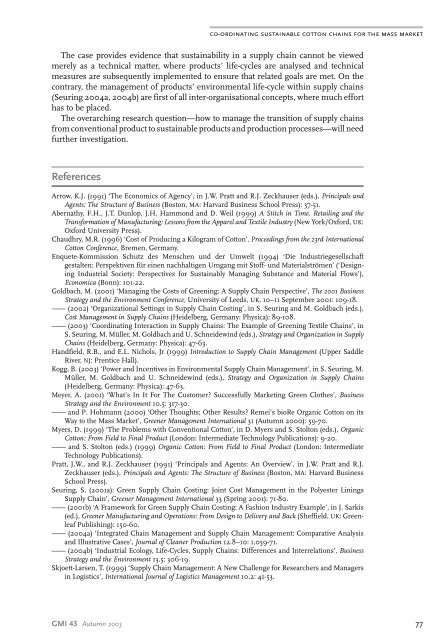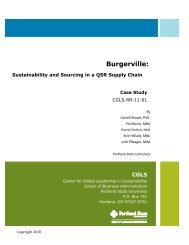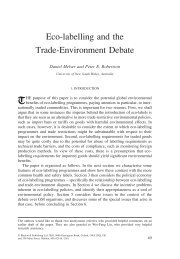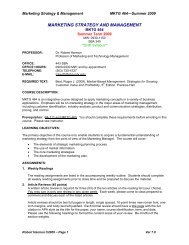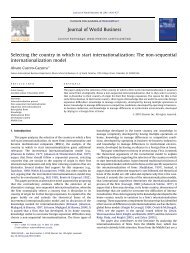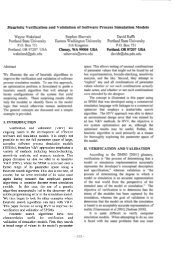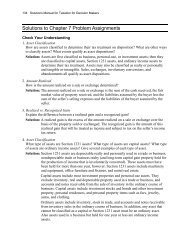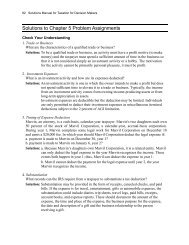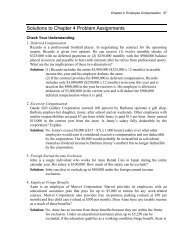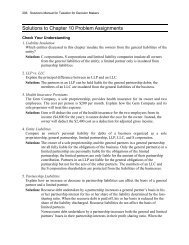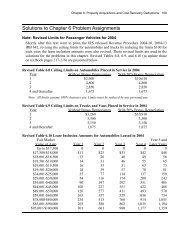Co-ordinating Sustainable Cotton Chains for the Mass Market
Co-ordinating Sustainable Cotton Chains for the Mass Market
Co-ordinating Sustainable Cotton Chains for the Mass Market
Create successful ePaper yourself
Turn your PDF publications into a flip-book with our unique Google optimized e-Paper software.
co-<strong>ordinating</strong> sustainable cotton chains <strong>for</strong> <strong>the</strong> mass market<br />
The case provides evidence that sustainability in a supply chain cannot be viewed<br />
merely as a technical matter, where products’ life-cycles are analysed and technical<br />
measures are subsequently implemented to ensure that related goals are met. On <strong>the</strong><br />
contrary, <strong>the</strong> management of products’ environmental life-cycle within supply chains<br />
(Seuring 2004a, 2004b) are first of all inter-organisational concepts, where much ef<strong>for</strong>t<br />
has to be placed.<br />
The overarching research question—how to manage <strong>the</strong> transition of supply chains<br />
from conventional product to sustainable products and production processes—will need<br />
fur<strong>the</strong>r investigation.<br />
References<br />
Arrow, K.J. (1991) ‘The Economics of Agency’, in J.W. Pratt and R.J. Zeckhauser (eds.), Principals and<br />
Agents: The Structure of Business (Boston, MA: Harvard Business School Press): 37-51.<br />
Abernathy, F.H., J.T. Dunlop, J.H. Hammond and D. Weil (1999) A Stitch in Time. Retailing and <strong>the</strong><br />
Trans<strong>for</strong>mation of Manufacturing: Lessons from <strong>the</strong> Apparel and Textile Industry (New York/Ox<strong>for</strong>d, UK:<br />
Ox<strong>for</strong>d University Press).<br />
Chaudhry, M.R. (1996) ‘<strong>Co</strong>st of Producing a Kilogram of <strong>Co</strong>tton’, Proceedings from <strong>the</strong> 23rd International<br />
<strong>Co</strong>tton <strong>Co</strong>nference, Bremen, Germany.<br />
Enquete-Kommission Schutz des Menschen und der Umwelt (1994) ‘Die Industriegesellschaft<br />
gestalten: Perspektiven für einen nachhaltigen Umgang mit Stoff- und Materialströmen’ (‘Designing<br />
Industrial Society: Perspectives <strong>for</strong> Sustainably Managing Substance and Material Flows’),<br />
Economica (Bonn): 101-22.<br />
Goldbach, M. (2001) ‘Managing <strong>the</strong> <strong>Co</strong>sts of Greening: A Supply Chain Perspective’, The 2001 Business<br />
Strategy and <strong>the</strong> Environment <strong>Co</strong>nference, University of Leeds, UK, 10–11 September 2001: 109-18.<br />
—— (2002) ‘Organizational Settings in Supply Chain <strong>Co</strong>sting’, in S. Seuring and M. Goldbach (eds.),<br />
<strong>Co</strong>st Management in Supply <strong>Chains</strong> (Heidelberg, Germany: Physica): 89-108.<br />
—— (2003) ‘<strong>Co</strong><strong>ordinating</strong> Interaction in Supply <strong>Chains</strong>: The Example of Greening Textile <strong>Chains</strong>’, in<br />
S. Seuring, M. Müller, M. Goldbach and U. Schneidewind (eds.), Strategy and Organization in Supply<br />
<strong>Chains</strong> (Heidelberg, Germany: Physica): 47-63.<br />
Handfield, R.B., and E.L. Nichols, Jr (1999) Introduction to Supply Chain Management (Upper Saddle<br />
River, NJ: Prentice Hall).<br />
Kogg, B. (2003) ‘Power and Incentives in Environmental Supply Chain Management’, in S. Seuring, M.<br />
Müller, M. Goldbach and U. Schneidewind (eds.), Strategy and Organization in Supply <strong>Chains</strong><br />
(Heidelberg, Germany: Physica): 47-63.<br />
Meyer, A. (2001) ‘What’s In It For The Customer? Successfully <strong>Market</strong>ing Green Clo<strong>the</strong>s’, Business<br />
Strategy and <strong>the</strong> Environment 10.5: 317-30.<br />
—— and P. Hohmann (2000) ‘O<strong>the</strong>r Thoughts; O<strong>the</strong>r Results? Remei’s bioRe Organic <strong>Co</strong>tton on its<br />
Way to <strong>the</strong> <strong>Mass</strong> <strong>Market</strong>’, Greener Management International 31 (Autumn 2000): 59-70.<br />
Myers, D. (1999) ‘The Problems with <strong>Co</strong>nventional <strong>Co</strong>tton’, in D. Myers and S. Stolton (eds.), Organic<br />
<strong>Co</strong>tton: From Field to Final Product (London: Intermediate Technology Publications): 9-20.<br />
—— and S. Stolton (eds.) (1999) Organic <strong>Co</strong>tton: From Field to Final Product (London: Intermediate<br />
Technology Publications).<br />
Pratt, J.W., and R.J. Zeckhauser (1991) ‘Principals and Agents: An Overview’, in J.W. Pratt and R.J.<br />
Zeckhauser (eds.), Principals and Agents: The Structure of Business (Boston, MA: Harvard Business<br />
School Press).<br />
Seuring, S. (2001a): Green Supply Chain <strong>Co</strong>sting: Joint <strong>Co</strong>st Management in <strong>the</strong> Polyester Linings<br />
Supply Chain’, Greener Management International 33 (Spring 2001): 71-80.<br />
—— (2001b) ‘A Framework <strong>for</strong> Green Supply Chain <strong>Co</strong>sting: A Fashion Industry Example’, in J. Sarkis<br />
(ed.), Greener Manufacturing and Operations: From Design to Delivery and Back (Sheffield, UK: Greenleaf<br />
Publishing): 150-60.<br />
—— (2004a) ‘Integrated Chain Management and Supply Chain Management: <strong>Co</strong>mparative Analysis<br />
and Illustrative Cases’, Journal of Cleaner Production 12.8–10: 1,059-71.<br />
—— (2004b) ‘Industrial Ecology, Life-Cycles, Supply <strong>Chains</strong>: Differences and Interrelations’, Business<br />
Strategy and <strong>the</strong> Environment 13.5: 306-19.<br />
Skjoett-Larsen, T. (1999) ‘Supply Chain Management: A New Challenge <strong>for</strong> Researchers and Managers<br />
in Logistics’, International Journal of Logistics Management 10.2: 41-53.<br />
GMI 43 Autumn 2003 77


